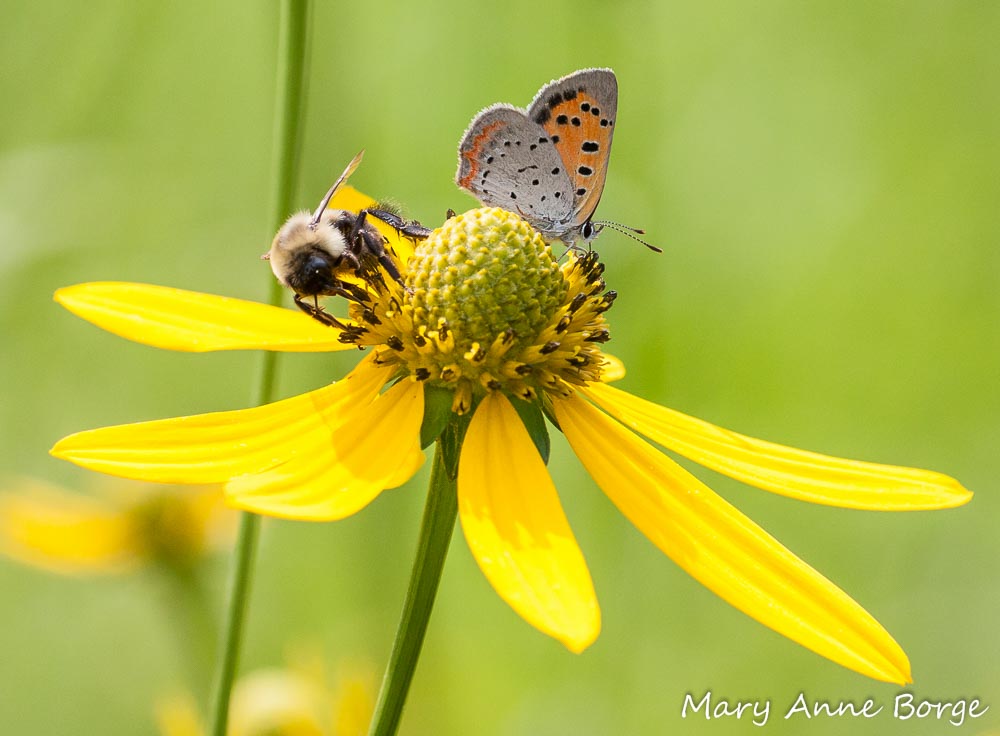
by Sheila Dunning | May 22, 2015
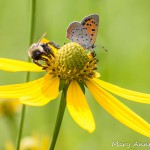 Everyone with a landscape can make a difference for pollinators. Simply Having Areas Reserved for the Environment enables homeowners, land managers, farmers, individuals, corporations, schools, roadside managers, and golf courses to increase the number of pollinators in the area by making conscious choices to include plants that provide essential habitat for bees, bats, birds, butterflies, moths, beetles, and hummingbirds. What better time than during National Pollinator Week, June 15-21, 2015.
Everyone with a landscape can make a difference for pollinators. Simply Having Areas Reserved for the Environment enables homeowners, land managers, farmers, individuals, corporations, schools, roadside managers, and golf courses to increase the number of pollinators in the area by making conscious choices to include plants that provide essential habitat for bees, bats, birds, butterflies, moths, beetles, and hummingbirds. What better time than during National Pollinator Week, June 15-21, 2015.
Initiated and managed by the North American Pollinator Protection Campaign, National Pollinator Week was unanimously approved and designated by the U.S. Senate in 2007. Each year since, the U.S. Secretary of Agriculture has signed the proclamation in an effort to address the urgent issue of declining pollinator populations.
Worldwide there is evidence that pollinating animals have suffered from loss of habitat, pesticide misuse, competition from invasive species, disease, and parasites. Many pollinators are federally “listed species”, meaning that there is documented information confirming the disappearance and/or significant population reduction in natural areas. The United States has lost over 50% of its managed honeybee colonies over the past ten years. The European Union has been so concerned that they invested over $20 million investigating the status of pollinators in Europe.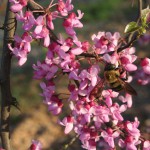
Pollinator health affects everyone. Worldwide, roughly 1,000 plants grown for food, beverages, fibers, spices, and medicines need to be pollinated by animals in order to produce the goods on which we depend. Food and beverages produced with the help of pollinators include: apples, blueberries, chocolate, coffee, melons, peaches, potatoes, pumpkins, vanilla, almonds, and tequila. In the U.S., pollination by honey bees, native bees, and other insects produces $40 billion worth of products annually.
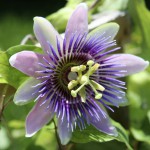 The native plants that can be identified and preserved or introduced include trees, shrubs, vines and perennials. Some of them include: Eastern Redbud (Cercis canadensis), Highbush Blueberry (Vaccinium spp.), Passionflower (Passiflora spp.), Coreopsis (Coreopsis spp.), Goldenrod (Solidago spp.), Black-eyed Susan (Rudbeckia hirta), and Butterfly Milkweed (Asclepias tuberosa). Simply identifying and avoiding damaging many of the existing native plants will allow anyone to provide important homes and food for many different pollinating animals. During National Pollinator Week S.H.A.R.E. your space.
The native plants that can be identified and preserved or introduced include trees, shrubs, vines and perennials. Some of them include: Eastern Redbud (Cercis canadensis), Highbush Blueberry (Vaccinium spp.), Passionflower (Passiflora spp.), Coreopsis (Coreopsis spp.), Goldenrod (Solidago spp.), Black-eyed Susan (Rudbeckia hirta), and Butterfly Milkweed (Asclepias tuberosa). Simply identifying and avoiding damaging many of the existing native plants will allow anyone to provide important homes and food for many different pollinating animals. During National Pollinator Week S.H.A.R.E. your space.
For additional information:
UF Native Buzz
Gardening for Pollinators
Minimizing Honey Bee Exposure to Pesticides
The Xerces Society
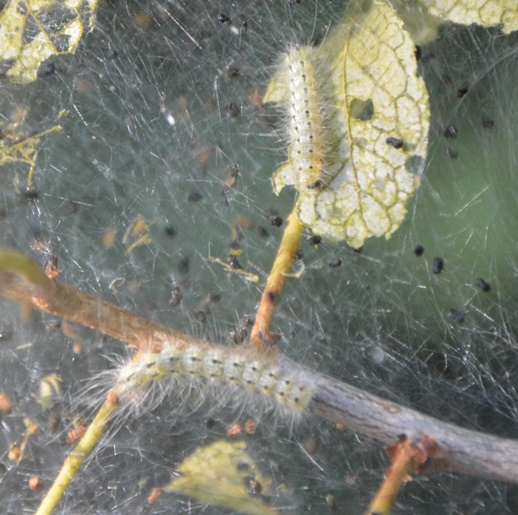
by Les Harrison | May 19, 2015
Uninvited guests can sometimes be fun and entertaining, bringing spontaneity to an otherwise predictable schedule. Sometimes the surprise guest is just an unpleasant distraction with no redeeming virtues.
The unanticipated knock on the door can bring both scenarios to mind. Almost everyone has an enjoyable cousin who regales listeners with amusing tales, and picks up the check for dinner.
Likewise, there are those potential callers with parasitic qualities, the appetite of a market hog, and initiative of a sloth. The Eastern Tent Caterpillar is one such visitor in north Florida.
These native caterpillars build large, thick nests on the branch forks and crotches of many kinds of trees, seeming to always choose the prized specimens highly valued by the homeowner. The silky tent shaped nests are easy to see and identity in host trees.
The caterpillars emerging in the spring of 2015 were laid in the spring of 2014. The adult moth lays her eggs in a single batch in May to July in the panhandle. There are 200 to 300 eggs laid in the group.
The mass of eggs are shiny, reddish-brown and look like dried foam. They are ordinarily about six inches back from the tip of a thin twig in host tree.
In approximately three weeks the eggs contain fully formed caterpillars, but the small caterpillars remain in the eggs until the following spring.
In late-February to mid-March they chew their way through their egg shells ready to eat their host tree that is entering the spring budding period with plentiful tender vegetation.
The voracious larvae immediately infest and, if in sufficient numbers, defoliate plum, cherry and many others. Normally the trees recover after a few weeks, but weakened or diseased trees may die.
When not eating, the newly hatched caterpillars construct their silk tent. The caterpillars use a pheromone trail to guild them back home when foraging is done.
A social insect, the eastern tent caterpillars congregate at their specific tent during the night and in rainy weather, expanding it to accommodate their growing size. These caterpillars do not feed within their nests.
The caterpillars disperse to colonize new areas when maturity is reached. They construct cocoons in protected places once they have sufficiently scattered.
Birds are not attracted to these hairy caterpillars. If they have a heavy concentration of black cherry leaves in their diet, the caterpillars will have a bitter acrid taste.
Parasitic wasps and weather are the two most common causes of caterpillar death. These caterpillars are especially susceptible to cold weather once they have emerged from their eggs.
About two weeks later, an adult moth emerges to begin the process again. Mating and egg laying commonly occur within 24 hours of the moths emerging from their cocoons
These brown moths are nocturnal and are seen flying only at night. They are an inch to two inches wingtip to wingtip at maturity and easy to overlook.

Tent Caterpillars are quick to hatch and eat their way through home landscapes.
Unfortunately, once they arrive for a visit they always overstay their welcome.
Contact your local UF/IFAS County Extension Office to learn more about Eastern Tent Caterpillars in north Florida.
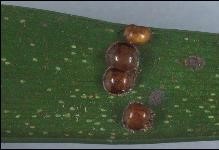
by Eddie Powell | May 8, 2015

Florida soft scale. Photo credit: UF/IFAS.
Scale insects are one of the most serious problems homeowners face on ornamentals this time of year. The most common are armored scale, soft scale, and mealybugs. They cause damage by sucking plant fluids from the leaves, stems, and sometimes roots. Some species feed on the underside of the leaves which can appear as yellowing spots or chlorotic lesions. Heavy infestations can cause extensive leaf yellowing, premature leaf drop, branch dieback, and plant death.
The life cycle starts when the eggs are laid beneath a waxy covering or beneath the adult female. After the eggs hatch two to three weeks later, the nymphs (crawlers) move around the plant until they find a suitable feeding site. Crawlers then insert their straw-like mouthparts into the plant and begin to feed and grow. The male often develops wings and flies to locate a mate.
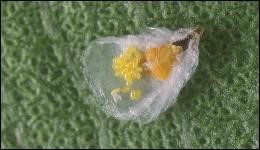
Armored scale nymphs. Photo: UF/IFAS.
Armored scale is distinct from other types of scales because they secrete a waxy covering over their body that is not attached to the body. The scale lives and feeds under this covering ranging 1/16 to 1/8 inch in size. They can be any color or shape, depending on the species. Armored scale does not produce honeydew.
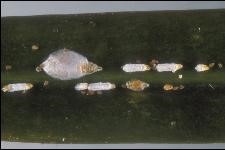
Armored scale. Photo credit: UF/IFAS.
Soft scale also secretes a waxy covering but it is attached to the bodies. Soft scales vary in color, size, and shape. They are circular shaped and range from 1/8 to ½ inch in diameter. Because they consume so much plant sap, they excrete a lot of sugary liquid called honeydew. Honeydew is the sticky liquid found on the leaves.
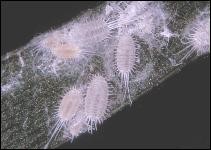
Mealybugs. Photo credit: UF/IFAS.
Mealybugs are soft bodied insects that are often covered with cottony white filaments. They are 1/8 inch in size and feed on all parts of plants. Injured plants have discolored, wilted, and deformed foliage.
Sooty mold is caused when mealybugs and soft scales excrete large amounts of honeydew which provides an excellent medium for the growth of the black fungus. Sooty mold is not only unattractive; it slows down the growth of the plant as it interferes with photosynthesis. Over time, with the control of the insect population, the sooty mold will weather away. Ants can also play a big factor in controlling sooty mold as they will feed on the honeydew.
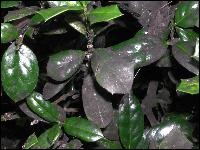
Sooty mold. Photo credit: UF/IFAS.
To control scale and mealybugs, avoid over-fertilizing and monitor your plants often. If the infestation becomes over-bearing, spray a fine mist of Horticultural Oil on the foliage. Avoid spraying in the summer heat because of damaging foliage. Other chemicals that can be used if necessary are Sevin dust and Malathion.
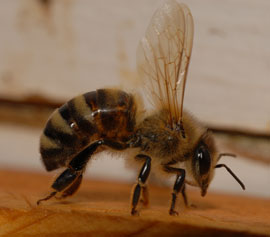
by Sheila Dunning | Apr 28, 2015
Bees have been disappearing at an alarming rate and continue to vanish without a trace. Why should anyone care? Well, they matter a lot more than most people think. Bees are the overwhelmingly dominant pollinator for most food crops. Native bees in the United States are responsible for pollinating over $15 billion worth of agricultural commodities annually. However, native bee populations are in decline due to habitat loss. At the same time, managed colonies of European honey bees have suffered a 50% decline over the past few decades. Numerous other pollinating insects are facing the same fate.

European honey bee. Photo credit: UF/IFAS.
As the spring planting season is upon us, it’s exciting to think about all the wonderful produce we will have this summer. But, without pollinators many of these crops would not be available. The majority of fruit and vegetable food sources we eat are dependent on insect pollinators. One of every three bites of food Americans consume comes from a plant visited by bees or other pollinators.
As declining numbers of farmers work to meets the need of increasing populations, they are forced to make choices on alternative to chemicals for pest control. “Good bug blends” of flowers can help attract pollinators as well as beneficial insects that suppress harmful pests. Establishment of these meadows can be done on a small or large scale and in any habitat. One approach to “bring back the pollinators” is to intercrop with blooming plants that attract insects. Selecting a diversity of plants with different flower sizes, shapes and colors, as well as various plant heights and growth habits, will encourage the greatest numbers of pollinators. It is important to provide a continuous source of pollen and nectar throughout the growing season. At minimum, strive for three species to be blooming at any one time; the greater the diversity the better.
To enhance the garden, choose flowering plants that also provide shelter for beneficial insects. Many companion plants are suitable habitat for predators and parasitoids. Research in Florida has demonstrated that predatory minute pirate bugs can build to high numbers in sunflowers. The favorite food of minute pirate bugs is Western flower thrips. So, planting sunflowers on the perimeter of vegetable crops, such as peppers, can greatly reduce the damage caused by the thrips. Similar results were found with the planting of sorghum to attract beneficial mites and intercropping with buckwheat to house syrphid flies and parasitoid wasps. The garden vegetables experienced fewer spider mite, whitefly and aphid problems. Crimson clover, Hairy vetch and cosmos are other annual seed crops that can aid in attracting pollinators and harboring beneficial insects.
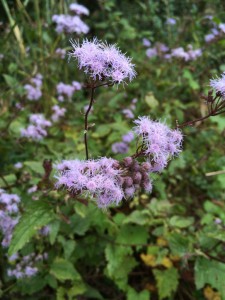
Blue Mistflower. Photo Credit Mary Derrick, UF / IFAS Extension.
Insectary meadows can be created in the landscape and along roadways, not just in the garden. For more permanently planted areas, native wildflowers, grasses and woody plants serve as larval host plants for butterflies, and also provide nesting and overwintering sites for bumble bees, predacious beetles and other beneficial insects. Native perennial wildflowers such as blanketflower, tickseed, black-eyed Susan, partridge pea, narrowleaf sunflower, milkweed, beebalm, goldenrod and silkgrass can be installed in the spring as potted plants or seeded in the fall. Seeds require exposure to cold temperatures and damp conditions before germination can occur. In Florida, the best time is November to February.
Though grasses do not offer nectar or high-quality pollen, it is often useful to include at least one native bunch grass or sedge. Short, clump-forming grasses are preferable to large, spreading grasses. Hedgerow planting of woody species is a way to provide winter-blooming plants vital for supporting pollinators. Woody plants and grasses provide more than forage for pollinators, as many native bee species nest in the stems of plants or in the undisturbed ground underneath plantings. Suitable grasses include: beaked panicgrass, purple lovegrass, Muhly grass, broomsedge,little bluestem, wiregrass and toothache grass. Favored woody species that make good “beetle banks” include: fetterbush, American beautyberry, saw palmetto, Chickasaw plum, red maple, sparkleberry, Dahoon holly, redbud, blackgum, magnolia, buttonwood and sourwood.
Regardless of whether the objective is to establish herbaceous or woody vegetation, the time and effort spent on eradicating undesirable plants prior to planting will result in higher success rates in establishing the targeted plant community. Choose level, open sites that receive full sunlight and have limited weed populations. If perennial weeds are a problem, the use of herbicides that have no soil residual (e.g. glyphosate) may be necessary.
For more information on establishing planting for pollinators visit: www.xerces.org/pollinator.
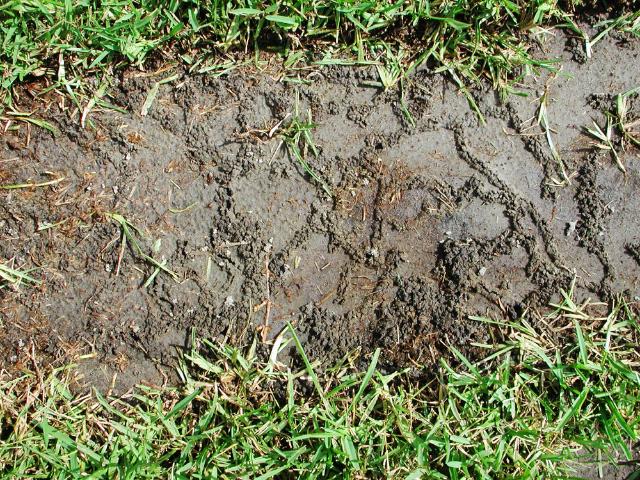
by Larry Williams | Apr 20, 2015
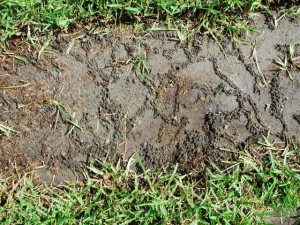
Mole cricket tunnels. Credit: N. Leppla, UF/IFAS
Many people treat their lawn with an insecticide when they see mole crickets in the spring or at the first sign of a brown area in their lawn. What they don’t understand is the biology of this pest.
Mole crickets spend the winter as adults in the soil. As temperatures warm in late February and March, adult mole crickets emerge and begin to mate. Male mole crickets construct a chamber in the soil and chirp to attract female crickets. Attracted females fly to the males. After mating, males die and females fly to a suitable area for egg laying. Mated females begin tunneling and laying eggs in the tunnels. They lay about four clutches of eggs in different areas, averaging 35 eggs per clutch. Female crickets die shortly after laying their eggs.
Use of insecticides during early spring is not recommended because:
- adult mole crickets are not easily killed
- they cause minimal lawn damage during the mating and egg laying process, and,
- reinfestation from subsequent flights is likely.
The best time to treat for mole crickets is during mid-June through July. This will be when eggs have hatched but before the nymphs (immature mole crickets) are large enough to do much damage. Proper timing of the insecticide application is very important to achieve control.
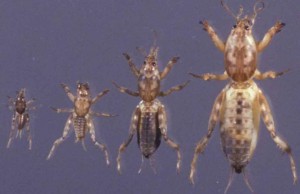
Mole cricket nymphs. Credit: J. Castner, UF/IFAS
If you are not sure if mole crickets are present, you can find out with a soap solution. Mix 1½ fluid ounces of a lemon scented liquid dishwashing soap in two gallons of water in a sprinkling can or bucket. Pour the soapy water over an area approximately four square feet and count the number of mole crickets that emerge. If they are present, it only takes several minutes for mole crickets to crawl to the surface after the soap treatment. Repeat the process around the yard where you suspect mole cricket problems. If you flush an average of two to four crickets per site, treat the lawn with an insecticide. Follow up with spot treatments if any crickets escape the first insecticide treatment. But don’t treat at all if there is no evidence of mole cricket activity.
There are a number of products for mole cricket control in home lawns. Look for insecticides that contain the following active ingredients: bifenthrin, carbaryl, cyfluthrin, deltamethrin, imidacloprid , lambda-cyhalothrin or permethrin.
Before using any product for mole cricket control first identify the problem as mole cricket damage by using the soap flush technique. Then choose an insecticide that lists mole crickets on its label. And finally, read the container carefully for use directions, application techniques, irrigation requirements and precautions.
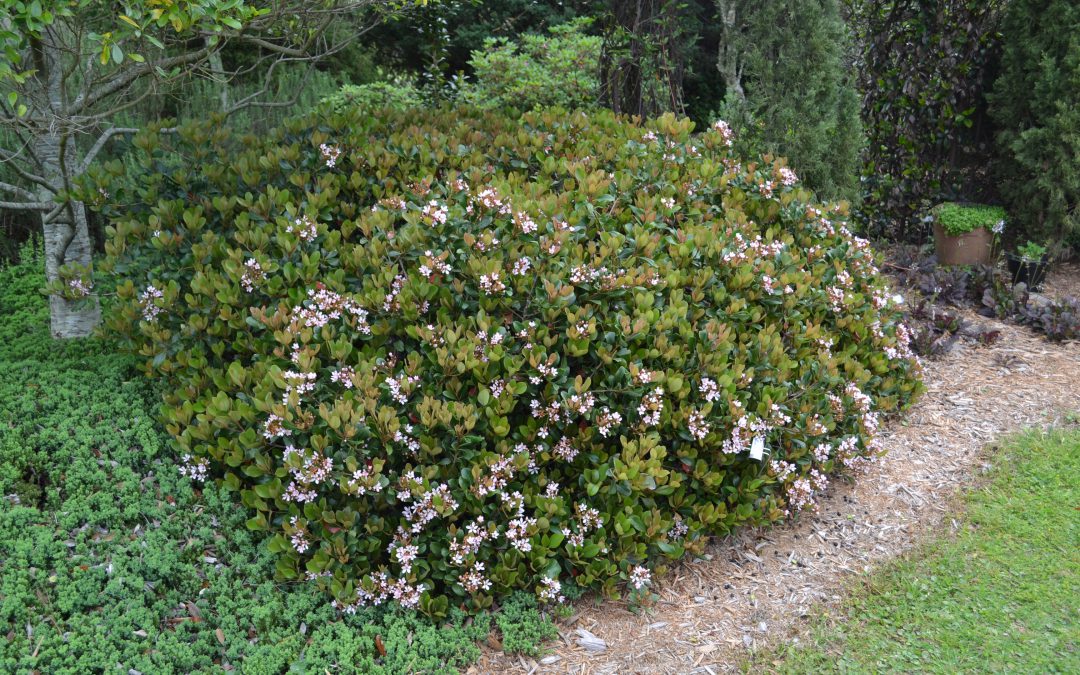
by Beth Bolles | Apr 7, 2015
One of the most commonly used shrubs in landscapes is the Indian hawthorn, Rhapheolepsis indica. Although not native to Florida, it can be a very attractive shrub when used properly in landscapes. Plants offer spring flowers in pinks and whites followed by berries that are a food source for birds.
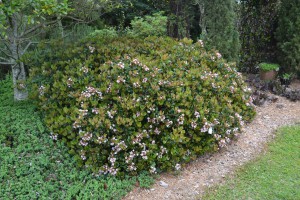
Indian hawthorn as a single planting can be attractive.
Indian hawthorn plants in landscapes are susceptible to a couple of pests that create unattractive and unhealthy plants. A leaf spot fungus called Entomosporium leaf spot easily spreads from infected plants through irrigation and rainfall leading to leaf discoloration, leaf drop, and dieback of limbs. Scale insects can also be common on leaves causing yellowing and dieback. The fungal problem is difficult to manage on heavily infected plants but the scale can be managed with a low toxicity pesticide choice such as a horticulture oil.
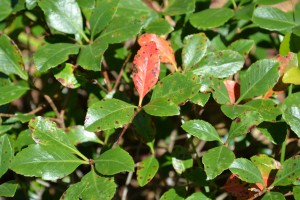
A heavy infection of leaf spot fungi is often too difficult to manage when plants are routinely irrigated.
Most often the problems on Indian hawthorn, especially fungal, are the result of poor management. This shrub likes sun, well-drained soil, and no overhead irrigation. Once established, plants should need little supplemental irrigation and water should only be applied to the base of plants. Since plants normally form a rounded mound, there is also little need for pruning if planted in a correct spot and spaced appropriately when planting. Most landscape installations of Indian hawthorn space plants based on the gallon pot size and not the mature size of the plant which is about 3-5 feet in height and spread.
Indian hawthorn can still be a good selection for homeowners. Buy healthy plants without any signs of spots on leaves and don’t plant a monoculture of these plants in the landscape. If one plant does have serious pest issue it is easier to either treat or remove one plant versus a mass planting.

 Everyone with a landscape can make a difference for pollinators. Simply Having Areas Reserved for the Environment enables homeowners, land managers, farmers, individuals, corporations, schools, roadside managers, and golf courses to increase the number of pollinators in the area by making conscious choices to include plants that provide essential habitat for bees, bats, birds, butterflies, moths, beetles, and hummingbirds. What better time than during National Pollinator Week, June 15-21, 2015.
Everyone with a landscape can make a difference for pollinators. Simply Having Areas Reserved for the Environment enables homeowners, land managers, farmers, individuals, corporations, schools, roadside managers, and golf courses to increase the number of pollinators in the area by making conscious choices to include plants that provide essential habitat for bees, bats, birds, butterflies, moths, beetles, and hummingbirds. What better time than during National Pollinator Week, June 15-21, 2015.
 The native plants that can be identified and preserved or introduced include trees, shrubs, vines and perennials. Some of them include: Eastern Redbud (Cercis canadensis), Highbush Blueberry (Vaccinium spp.), Passionflower (Passiflora spp.), Coreopsis (Coreopsis spp.), Goldenrod (Solidago spp.), Black-eyed Susan (Rudbeckia hirta), and Butterfly Milkweed (Asclepias tuberosa). Simply identifying and avoiding damaging many of the existing native plants will allow anyone to provide important homes and food for many different pollinating animals. During National Pollinator Week S.H.A.R.E. your space.
The native plants that can be identified and preserved or introduced include trees, shrubs, vines and perennials. Some of them include: Eastern Redbud (Cercis canadensis), Highbush Blueberry (Vaccinium spp.), Passionflower (Passiflora spp.), Coreopsis (Coreopsis spp.), Goldenrod (Solidago spp.), Black-eyed Susan (Rudbeckia hirta), and Butterfly Milkweed (Asclepias tuberosa). Simply identifying and avoiding damaging many of the existing native plants will allow anyone to provide important homes and food for many different pollinating animals. During National Pollinator Week S.H.A.R.E. your space.













